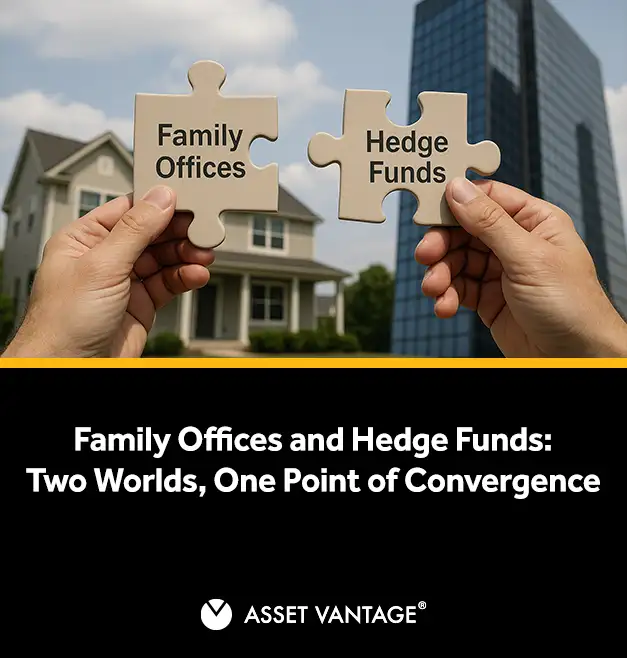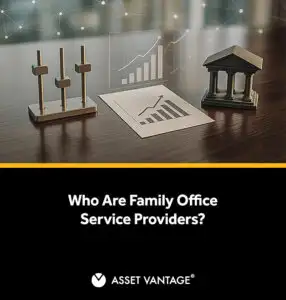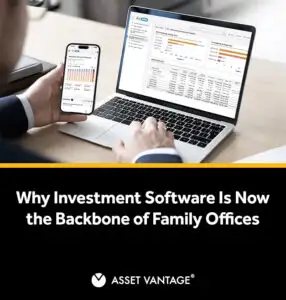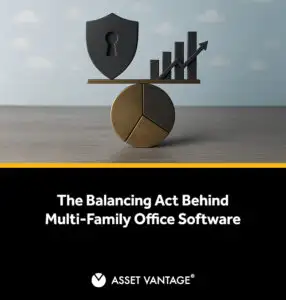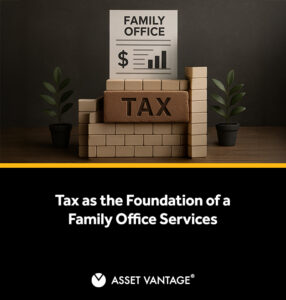Read Time15 Mins
- Family Offices and Hedge Funds: Two Worlds, One Point of Convergence
- Why Hedge Funds Transform into Family Offices
- Wealth Management Advantages in the Family Office Hedge Fund Model
- Case Examples: Why Big Names Walked Away
- Risks and Trade-Offs Few Managers Acknowledge
- Family Office Hedge Funds vs Other Structures
- How the Portfolio Changes After Conversion
- Operating Model Inside a Family Office Hedge Fund
- Future Outlook: Where the Trend is Heading
Family Offices and Hedge Funds: Two Worlds, One Point of Convergence
In recent years, these worlds have begun to converge. Rising regulation, fee pressure, and scrutiny are pushing hedge funds to adopt the privacy, governance, and long-term focus of family offices. Understanding both models is the first step to seeing why so many managers are crossing over.
What is a Family Office?
- Concierge services, including philanthropy coordination and travel management.
- Property management for real estate portfolios and family-owned assets.
- Education and governance frameworks to prepare younger family members for future leadership.
This breadth makes family offices one of the world’s most strategic structures for wealthy families seeking continuity and control.
What is a Hedge Fund?
Similarities in How Both Manage Investments
- They employ professional wealth managers to manage investments.
- They use structured reporting and data consolidation to track performance.
- They pursue diversification across asset classes, including private equity, private credit, and alternative assets.
The Big Split: Regulation, Fees, and Long-Term Goals
Although family offices and hedge funds share investment expertise, their missions diverge when regulation, costs, and objectives come into play. This is where the contrast becomes most visible.
| Criteria | Hedge Funds | Family Offices |
|---|---|---|
| Regulation | Heavy SEC filings, disclosures, and compliance | Operate under family office exclusion, with fewer disclosure requirements |
| Fees | “Two and twenty” model, under pressure from investors | No external fee model, all returns accrue to the family |
| Objectives | Beat benchmarks, meet redemption schedules | Preserve the family’s assets, link to succession planning, and legacy preservation. |
| Stakeholders | Outside capital: pension funds, mutual funds, institutional investors | Family office principals and family members |
Over the past decade, two-thirds of hedge fund managers who converted into family offices did so to escape external pressure. In recent years, rising interest rates, market volatility, and strain on business models have accelerated this shift. While hedge funds optimise for performance and scale, family offices optimise for control, privacy, and growing wealth that endures across generations.
Why Hedge Funds Transform into Family Offices
Regulation Pushes Managers Out
- Annual filings, stress-test requirements, and frequent examinations make hedge funds costly to run.
- Lawsuits and regulatory penalties risk not just assets under management, but personal reputations.
Fees and Scrutiny No Longer Justify the Effort
- Pension funds and institutional investors demand steep discounts.
- Performance fees are harder to defend in volatile markets.
Cost Savings Mean Lighter Infrastructure
- No need for investor roadshows or fundraising teams.
- Lower legal and accounting expenses due to reduced disclosure.
Control And Privacy Drive The Shift
- Take concentrated positions without public scrutiny.
- Allocate freely to private credit, venture capital, and direct deals.
- Avoid explaining strategic bets to pension funds, mutual funds, or activist investors.
Legacy Planning Becomes Easier
- Estate and succession planning are embedded directly into investment decisions.
- Governance rules formalise decision rights between senior and younger generations.
- Structures ensure assets transfer smoothly without forced sales or dilution of control.
Wealth Management Advantages in the Family Office Hedge Fund Model
The family office hedge fund model shifts wealth management away from quarterly performance and toward continuity. Focusing on family values and long-term goals allows wealthy families to integrate investments, governance, and succession into a single framework. This structure creates advantages that traditional hedge funds cannot replicate.
Investment Strategies Aligned With Wealthy Families
- Allocations include alternative investments, private equity, venture capital, and private companies.
- According to UBS’s 2025 Global Family Office Report, alternatives now make up about 44% of allocations across leading family offices, led by private equity, real estate, and direct investments. Aleta
- In 2023, private equity via direct investments and funds/funds-of-funds each averaged around 11% of portfolios.
Unlike private bankers or fund managers, advisors are independent. They answer to the family, not to products or quarterly targets. This independence makes them central to building successful family offices that endure beyond a single generation.
Direct Investments And Private Credit
- Direct investments allow families to co-invest in private companies alongside trusted partners.
- Private credit strategies provide yield and liquidity while bypassing crowded public markets.
- Freedom from investor mandates enables families to structure deals that balance return with governance control.
Growing Wealth Across Generations
- Philanthropy coordination and impact investing align wealth with values.
- Structured governance ensures that growing wealth supports both senior and younger generations.
- Education initiatives prepare heirs for succession and decision-making responsibilities.
Customisation Of Risk Management
- Leverage limits reflect family governance rules.
- Liquidity strategies encompass legacy planning and long-term objectives.
- Asset allocation decisions balance preservation with selective risk-taking in alternative assets.
Customisation ensures that generational wealth is protected while still taking advantage of opportunities across market cycles.
Case Examples: Why Big Names Walked Away
John Paulson’s Pivot To A Family Office
George Soros And The Soros Precedent
A Growing Trend Over The Past Decade
- Media reporting in Nasdaq (2023) named John Paulson, Leon Cooperman, and Jonathan Jacobson among notable figures who shifted away from external investor capital
- A 2019 Business Insider interview saw Paulson estimate that roughly 75-80% of his firm’s assets were already his own, foreshadowing the conversion.
Risks and Trade-Offs Few Managers Acknowledge
Loss Of Scale And Deal Access
- Reduced clout in sourcing large-ticket deals (private equity, pre-IPO rounds).
- Diminished access to prime-broker leverage, margin financing, or discounted trading costs.
- Weaker negotiating power on custody, advisory, and fund operations.
Talent And Incentives
Family offices may struggle to recruit and retain elite investment talent when compensation structures and career visibility are more limited.
- A recent HSBC / Campden Wealth survey found 36% of family offices cited a lack of candidates with the right personal qualities, and 32% pointed to weak interpersonal skills as barriers.
- In parallel, Botoff Consulting reported 53% of family offices intend to hire additional staff this year, but many warn that competition with hedge funds and private equity firms for talent remains fierce.
Track Record Limitations
Running privately may give freedom, but it also changes how performance is assessed.
- Reporting standards differ: outside investors expect regular fund audits, peer-comparisons, and market disclosures. Private family office returns may lack transparency to external evaluators.
- If a manager ever wants to return to outside capital, institutional investors may discount or disqualify some “private” performance. Past gains may not translate well into new fundraising.
Costs Borne Entirely By The Family
- Family office principals must cover legal, accounting, risk, and operations costs in full.
- Down periods or portfolio underperformance hit personal wealth more directly.
Regulatory Spotlight Can Return
- Archegos is the example most often cited. Despite being classified as a family office, it utilized derivative instruments and concentrated its investments to amass a huge exposure. Regulators later charged its CEO with fraud and market manipulation after the company’s collapse exposed tens of billions of dollars in losses.
- In U.S. law, the family office exemption is under review; the Congressional Research Service has flagged Archegos as a case illustrating that lightly regulated entities may pose systemic risk.
Family Office Hedge Funds vs Other Structures
Comparison Table: How Structures Differ
| Criteria | Hedge Funds | Family Office Hedge Funds | Family Offices (Single-Family) | Multi-Family Offices | Private Equity Firms |
|---|---|---|---|---|---|
| Capital Base | External investors such as institutional investors, pension funds, and high-net-worth individuals | Family’s assets only | One family’s assets only | Multiple families pool resources to share infrastructure | External investors, endowments, sovereign funds |
| Regulation | SEC filings, disclosures, and compliance requirements | Family office exclusion with fewer disclosure requirements | Family office exclusion under the SEC rule | The same exemption applies, but complexity rises as more families join | SEC filings, fundraising rules, and investor reporting |
| Fee Model | “2 and 20” (management + performance fees), under pressure in recent years | No external fees; returns accrue to family office principals and family members | No external fees; costs fully borne by the family | Shared cost model: families pay proportionate fees to cover services | Management fee plus carried interest (“2 and 20” common) |
| Focus | Beating market benchmarks, quarterly performance | Privacy, control, alignment with family values, and long-term goals | Governance, succession, lifestyle, and preservation of family wealth | Cost efficiency, pooled access to expertise, and basic governance | Growth in private companies, exit strategies, and capital appreciation |
| Services | Asset management only | Asset management, customised reporting, tailored risk management | Wide array: wealth management, philanthropy coordination, concierge services, succession planning, travel management | Standardised wealth management, reporting, and administrative services | Investments in private companies only; limited family governance |
Interpreting The Differences
- Capital base: Hedge funds and private equity firms depend on external capital, while family offices and family office hedge funds rely solely on the family’s assets. This reduces conflicts of interest but concentrates risk on the family balance sheet.
- Regulation: Hedge funds and private equity are heavily regulated, while family office hedge funds operate under the lighter family office exclusion, avoiding most public filings. This privacy is often a primary reason for conversion.
- Fee model: Hedge funds and private equity firms earn fees from outside investors, but family office structures eliminate external fees altogether. This keeps returns within the family but removes the cushion of fee income to cover costs.
- Focus:Hedge funds chase benchmarks, private equity firms chase company growth, but family offices tie investments to succession planning, legacy, and family governance. Family office hedge funds sit in between, focused on performance but on the family’s terms.
- Services: Only family offices offer broad lifestyle services (concierge, philanthropy, education), which underscores their role as both a financial and personal governance institution.
How the Portfolio Changes After Conversion
From Quarterly Benchmarks to Asset Allocation Around Goals
- Survey data from the 2025 Global Family Office Survey by BlackRock found that 42% of family office portfolios are now allocated to alternative investments, up from 39% in previous years.
- A 2024 J.P. Morgan report shows averages close to 45% allocation into alternative assets (private equity, venture capital, real estate, hedge funds, etc.) among surveyed single-family offices.
Wider Use of Alternative Assets
- In BlackRock’s 2025 survey, nearly 32% of family offices intend to increase allocation to private credit in 2025-2026. Infrastructure is similarly rising.
- UBS’s data confirms this: in one report, about 31% of portfolios had allocations to private equity (11%) and private debt (6%) as part of their alternative asset mix.
These asset classes are chosen for their potential illiquidity premium and ability to generate returns outside public-market volatility. The conversion enables a family office hedge fund to accept more extended holding periods and less frequent valuation updates.
Direct Oversight of Data Aggregation and Reporting
- BlackRock’s survey shows 57% of family offices identify “gaps in internal expertise around reporting, deal-sourcing, and private-market analytics,” prompting investment in platforms and outsourced partners to manage data, risk, and performance reporting.
- The 2025 survey of single-family offices by BNY Wealth reports that nearly two-thirds expect to make six or more direct investments in the following year, reinforcing that direct deal tracking, performance attribution, and oversight become core capabilities.

